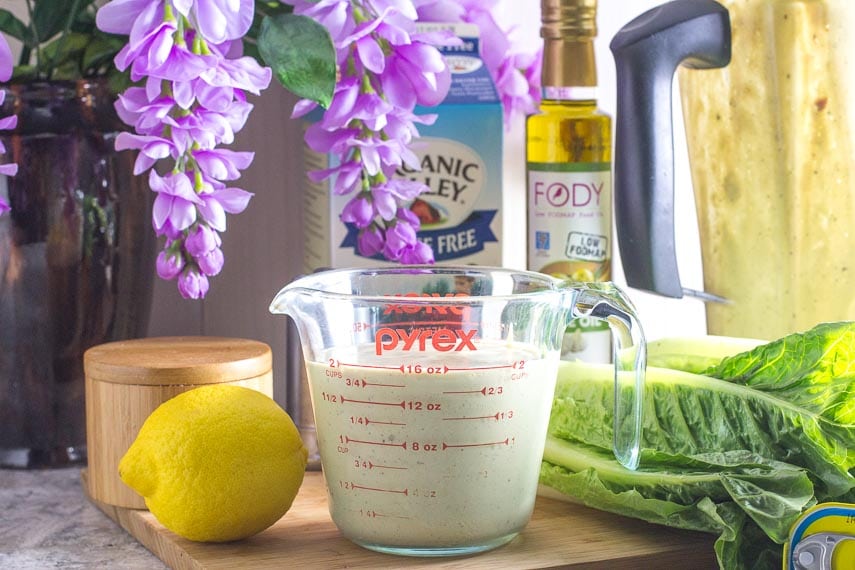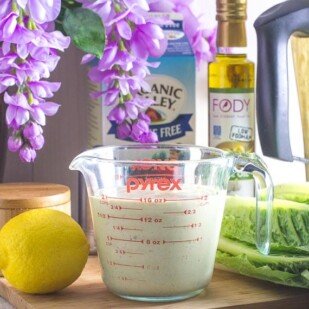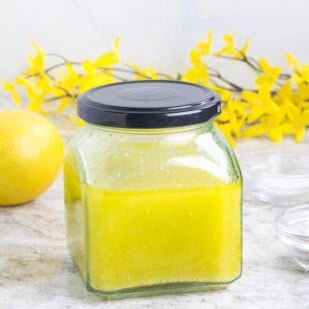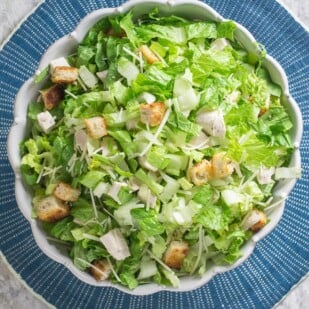Looking for The Best Homemade Creamy Caesar Salad Dressing? This Is It!
This is, hands down, the best low FODMAP Creamy Caesar Salad Dressing that you can make without using an almost raw or barely cooked egg. Did I lose you there?
A few classic early renditions of the dressing included a 1-minute coddled egg, which provided body and creaminess to the dressing, which by the way did not include anchovy filets (but did include Worcestershire sauce, which contains anchovies).

What Is Classic Caesar Salad & Dressing?
Caesar Cardini ran Caesar’s Place in Tijuana, Mexico and his namesake creation dates to the Fourth of July weekend of 1924. Around this time prohibition was in effect and movie stars and moguls from southern California would hightail it down to Tijuana to party.
The exact details are murky, but a journalist named Martin S. Lindsay has done some remarkable sleuthing, which you can read in his article HERE.
Probably True
Worcestershire sauce might have been added to the original, hence the mistaken assumption that it contained anchovies themselves.Caesar Salad Dressing Improvisations
You can find bottled Caesar Salad Dressings, versions made in homes and even chain restaurants (lots of chain restaurants) and many recipes online and in books – and they all have some relation to the original, but liberties have been taken.
Some use mayonnaise as a base. Some include anchovies and/or Worcestershire sauce. When eggs are used they can vary from raw to boiled for several minutes. Parmesan has largely replaced Romano. The croutons seem to remain constant, although their quality can range from sublime to stale and not worth eating.
Here are what seem to be the most common denominators:
- There should be a creaminess to the dressing and this can come from eggs but it can also be created in other ways.
- Romaine is the only lettuce to use.
- Parmesan cheese appears to be acceptable and expected by many.
The salad has umami. Between the Romano or Parmesan and the anchovies or Worcestershire sauce there is plenty of “savoriness” and “deliciousness” to this dish.
Croutons should be made fresh. Okay maybe that’s just my dictum but seriously, pre-made croutons are horrible. And they probably have garlic and possible other FODMAPs, so take the time to make them.
And, while rubbing a garlic clove on a wooden bowl might end up being low FODMAP, we don’t think Monash or anyone else for that matter is going to be lab testing wooden bowls anytime soon. So we are using Garlic-Infused Olive Oil.
I have opted to create creaminess with a low FODMAP buttermilk and the Parmesan cheese, as many folks would rather not have a near-raw egg.
So let’s get to our recipe for the dressing and then use it to great effect in our Chopped Chicken Caesar Salad! Our version is thick, creamy and very tangy and packed with umami!

The Best Homemade Low FODMAP Caesar Salad Dressing
Want to make the absolutely Best Homemade Low FODMAP Caesar Salad Dressing? This is it! Make extra as a dip for raw and steamed veggies.
Low FODMAP Serving Size Info: Makes 2 cups (480 ml); serving size 3 tablespoons
Ingredients:
- 1/2 cup (120 ml) lactose-free whole milk
- 6 tablespoons plus 2 teaspoons fresh squeezed lemon juice, divided
- 1 cup (240 ml) Garlic-Infused Oil , made with olive oil or a prepared version such as FODY Garlic-Infused Olive Oil
- 2/3 cup (66 g) grated Parmesan cheese
- 12 flat anchovies, packed in oil, drained (this is usually a 2 ounce/55 g tin)
- 1 tablespoon plus 1 teaspoon Dijon mustard
- 1 tablespoon plus 1 teaspoon Worcestershire sauce
- 1 teaspoon kosher salt
- Lots of freshly ground black pepper
Preparation:
-
Pour milk and 2 teaspoons of lemon juice into carafe of blender and allow to sit and thicken, about 5 minutes. Add the remaining lemon juice, garlic-infused oil, Parmesan, anchovies, Dijon mustard, Worcestershire sauce, salt and several grinds of pepper. Blend on high speed until smooth and creamy. Taste and adjust seasoning as desired.
-
Dressing is ready to use or may be refrigerated in an airtight container for up to 3 days. If it overly thickens you can thin with a little water.
Notes:
Tips
- We love this creamy, tangy salad dressing on pasta salad, too! Try it!
Nutrition
All nutritional information is based on third-party calculations and should be considered estimates. Actual nutritional content will vary with brands used, measuring methods, portion sizes and more. For a more detailed explanation, please read our article Understanding The Nutrition Panel Within Our Recipes.








The quantity of the lemon juice has GOT to be off! My face turned inside-out, this was so sour! It must be 6 TEASPOONS, plus 2 teaspoons, not tablespoons. Horrible. Absolutely horrible and inedible! Was like eating pure creamy lemon juice.
So sorry you didn’t enjoy it. The amount is correct and as you can see, there are 31 Five Star votes. You could adjust it to your liking and it would remain low FODMAP even if you lowered the acid component.